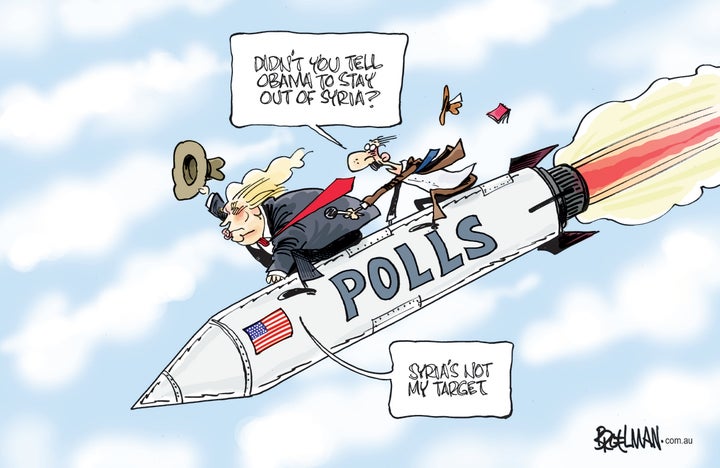
It was a predictable act. When a leader is embroiled in intractable domestic problems, with sliding approval ratings and a federal investigation into members of his administration, launching guided missiles may be the best cop-out. But beyond the question of motives and legality --as important as they are-- Trump's decision last week to launch $90 million worth of missiles on the small Shayrat Syrian Air Force base, from which fixed-wing aircraft took off hours later, is likely to have unintended but dangerous consequences.
Washington has squarely accused President Bashar al-Assad of carrying out the suspected chemical weapons attack of 4 April on Khan Sheikhoun, a village mostly controlled by the Tahrir-al-Sham alliance, an offshoot of the al-Nusra front classified by the UN as a terrorist organization. Challenged as we are to keep apace with President Trump’s reversals and boisterous positions, his subdued Secretary of State tried to tone down US accusations that Moscow must have known about the attack. Accusing Assad is one thing; accusing Putin of complicity is a different matter.
For now, Moscow is challenging Washington to have an impartial international investigation. But as an indication of the unproductive Putin-Tillerson talks on 12 April, the US and its allies, the UK and France, pushed the Security Council to act on a draft resolution they knew Moscow would veto. For good reason, Russia, China and others are wary of post facto investigations: President Trump gave the order to launch 60 Tomahawks (one misfired) before the UN Security Council, chaired by his Ambassador, Nikki Hailey, had convened to discuss a draft resolution to establish an international investigation. After the episodes of Iraq and Libya, many see such resolutions as a prelude to illegal and disastrous military campaigns.
As expected, the US media has not questioned Washington's assertions that Assad was guilty as charged. Instead, TV personalities and pundits have hailed the launch of Tomahawks -- one of the star anchors, Brian Williams, went as far as calling the missile launches 'beautiful'. But none have contemplated, even as a remote possibility that, absent hard evidence, the suspected use of nerve agents at Khan Sheikhoun could be the macabre deed of others. The question, as implausible as it may seem, needs to be asked --and answered.
In a post 9/11 era, major US media outlets are averse to challenging the official narrative on national security issues, even in light of a history of debunked accusations. Many will remember President Clinton's wag the dog moment when he ordered on 20 August 1998 Tomahawk missile strikes against the al-Shifa factory (which produced half of Sudan's medicines), accusing it of producing VX-nerve gas precursors, and al-Qaida targets in Afghanistan. Sudan rejected the accusations and implored the US and the United Nations to send investigatory missions. The US vetoed; none went. Years later, American officials conceded that the evidence was inconclusive. The strikes against al-Qaida's training camps at Kandahar, did not decapitate the organization, but probably bolstered it. And of course, everyone will remember the case of the never-to-be found WMDs in Iraq, used to justify the 2003 Bush-Blair invasion. Back then, as today, media outlets accustomed to demonizing unsavory dictators displayed knee-jerk reflexes.
Emboldened by the current media love fest, with networks largely in awe of America's military prowess, Trump authorized, directly or indirectly, the first battlefield use of the US’ largest conventional bomb, the GBU-43/B aka Massive Ordnance Air Blast bomb, reportedly dropped on ISIS tunnel networks in Afghanistan. Trump called it 'another very, very successful mission'. The Afghan Ministry of Defense said that up to 36 suspected ISIS militants were killed by the blast of the massive bomb, priced at $16 million.
Ordering spectacular and costly displays of military might may give Trump a sense of instant gratification and glory -- and a much-needed lift in the polls. But it should alarm US lawmakers and maybe awaken a quiescent and acquiescent US media to the fact that their new President is trigger happy: in March, the US conducted one drone strike every 1.8 days (compared to Obama’s 5.4 days average), reportedly killing in Syria, Iraq, Afghanistan, Yemen and Somalia over 1000 civilians, 200 of them in Mosul alone. Sixteen years after 9/11, the proclaimed war on terror seems to have promoted rather than undermined, emboldened rather than weakened, and spread rather than contained extremist groups and their ideologies.
But an even greater danger is now looming. After ordering the USS Carl Vinson aircraft carrier group to the Sea of Japan, Trump's statement that 'North Korea is a problem; the problem will be taken care of' has brought to a boiling point the simmering Korean crisis; so much so that the usually cautious and guarded Chinese officials are openly speaking about the risk of war. Are we on the brink of a renewed military confrontation on the Korean peninsula, this time between nuclear powers with two impetuous leaders at their helm? With almost 30.000 US military personnel in the Demilitarized Zone and South Korea’s capital of 25 million people in artillery range of Kim Jong Un’s arsenal, China and the US' allies in the region will have to make it clear to Trump: guided missiles may hit their targets -- but they do not produce guided policy.
